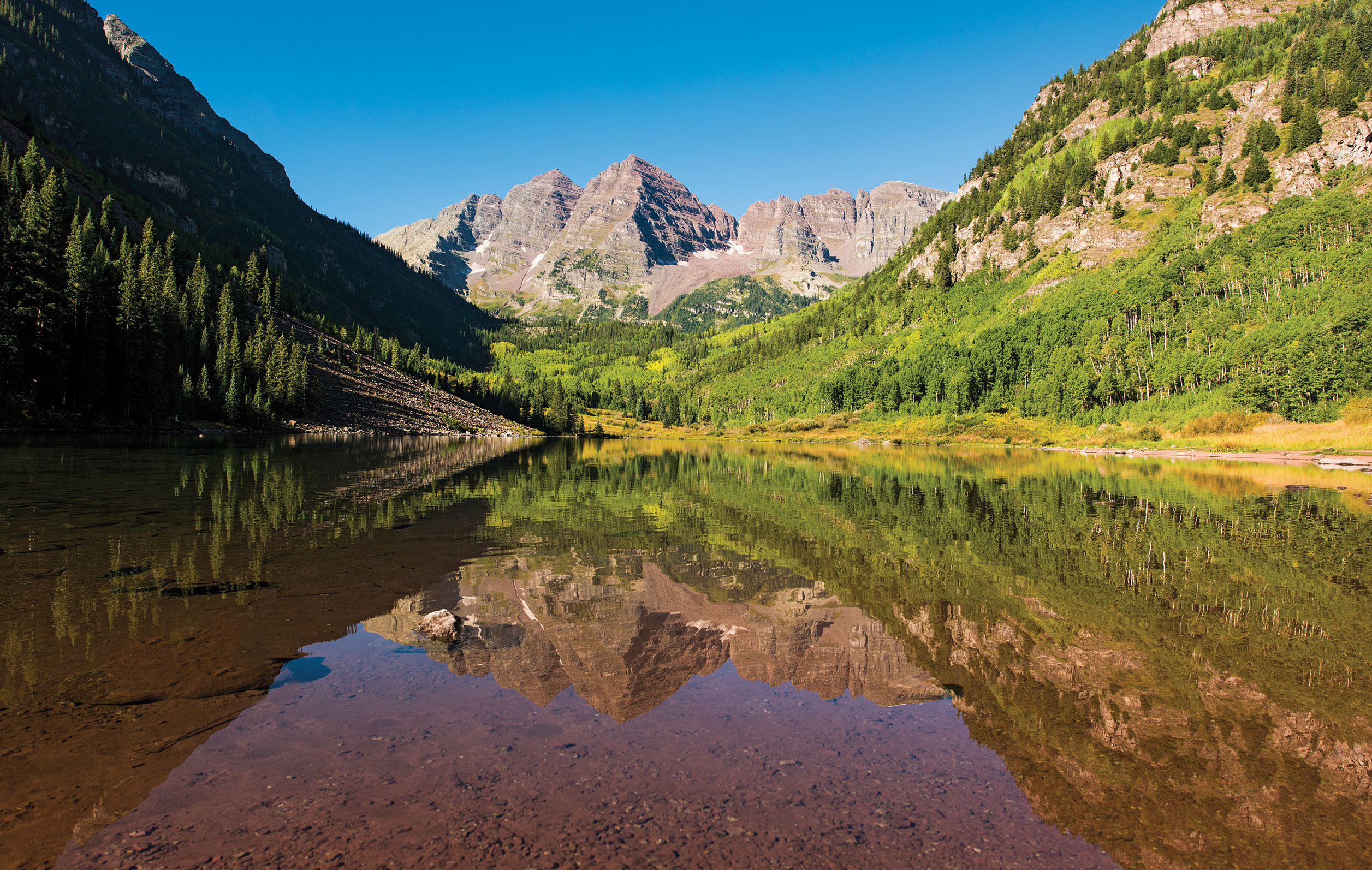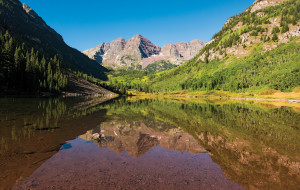Try to picture Colorado’s water situation 30 years from now, and you’ll likely conjure images of brown lawns, wilting crops, and dry creek beds where anglers and kayakers once played. With the state’s population projected to double by 2050, the Colorado River Basin already experiencing the lowest flows in a century, and the state projecting a 181-billion gallon annual water shortfall by mid-century, it’s easy to imagine a bleak future.
But John McCray sees it differently. The Mines professor of civil and environmental engineering envisions a future in which everything from hydraulic fracturing water (frack water) to toilet water is cleaned up and re-used—the solid “waste products” recycled into fertilizer for crops or fuel to
power water treatment plants. Rather than the customary practice of shipping water in from hundreds of miles away, using it once, then discarding it, communities will collect, treat, use, re-use, and store more local water, which often leaks out or evaporates in transit. Meanwhile, developers will routinely design neighborhoods to catch stormwater for irrigating parks and golf courses.
“I’m not worried,” says McCray, principal investigator for the Minesbased Engineering Research Center for Re-Inventing the Nation’s Urban Water Infrastructure (ReNUWIt). “We’ll just have to start using water smarter, and some of the policies that have made it difficult for us to do so will have to be revised. You’re already starting to see it happen.”
McCray is among dozens of researchers, students, and alumni working to put Mines on the map as a hub of innovative solutions to the West’s looming water crisis. With roughly 55 graduate students, Mines’ Hydrologic Science and Engineering (HSE) program is among the top hydrology programs in the nation. The 10-year NSF-funded ReNUWIt program (a collaboration with three other universities) is churning out ideas on how to improve the country’s aging urban water systems. At the ConocoPhillips Center for a Sustainable WE²ST (Water-Energy Education, Science and Technology), graduate students are exploring how to best reclaim water from oil and gas sites.
As McCray puts it, “We have strength in numbers here.”
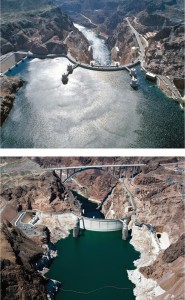
The top image, taken in March 1998, shows Lake Mead’s water level behind the spillway at Hoover Dam at 1,196 feet. By June 2015, Lake Mead’s elevation had dropped dramatically to 1,075 feet (bottom image), a decline of 121 feet.
(Top photo credit: U.S. Department of the Interior-Bureau of Reclamation/Andrew Pernick; Bottom photo credit: U.S. Department of the Interior-Bureau of Reclamation/Alexander Stephens)
Long Road, New Map
Colorado’s water woes date back to 1922, when the Colorado River Compact spelled out how much water originating in the state had to be shared with downstream neighbors. The Upper Basin states (Colorado, Utah, Wyoming, and New Mexico) and the Lower Basin states (California, Arizona, and Nevada) each lay claim to 7.5 million acre-feet per year in perpetuity (one acrefoot is enough water to cover a football field at a depth of one foot). According to the terms of the compact, Colorado received rights to 51 percent of the Upper Basin share. Eight subsequent compacts did the same for other rivers originating in the Rocky Mountains.
The problem: “They happened to do this during one of the wettest periods in history,” explains McCray. As a result, more water has been allocated than actually exists in the river today. “If everyone downstream decides to use their water rights at the same time, that will be a problem.”
Population growth and climate change are also at play. Colorado’s population soared from 1 million in 1930 to 5 million today and could hit 9.2 million by 2050, according to state agencies. Higher, dryer days are expected to boost water demand by as much as 8 percent. Meanwhile, frequent forest fires and windy “dust on snow” events also impair supply. By 2050, the state could be short 560,000 acre-feet of water annually for municipal and industrial needs.
With all this in mind, in November 2015 the Colorado Water Conservation Board (the agency tasked with protecting and developing state water sources) unveiled the first-ever state water plan, a 400-page tome designed to bring stakeholders together to fend off the impending shortfall. “We didn’t just speak on the 50,000-foot level,” says Rebecca Mitchell ’02, MS ’07, the state’s section chief for water supply planning, who helped write
the plan. “We set a specific goal and the actions that needed to happen to support that goal. That was a huge step forward.”
While 89 percent of water in the state goes to agriculture, much of the plan is focused on the 11 percent used by homeowners and industry. The plan aims to reduce the projected gap from 560,000 acre-feet to zero acre-feet by 2030. To do that, it aims to save 400,000 acre-feet via conservation. But the plan also makes a strong call for more water re-use and better planning, declaring that “by 2025, about 75 percent of Coloradans will live in communities that have incorporated water-saving actions into their land-use planning.”
“We didn’t want easily achievable goals. We wanted stretch goals,” says Mitchell. “We wanted to create an environment where people would be pushing on technology and knocking on the door with innovative solutions.” That’s where Mines comes in.
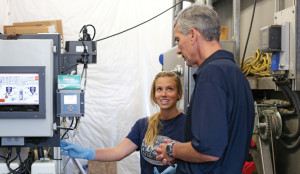
Graduate student Tori Frank explains the study she conducted for her master’s thesis to Mines president Paul C. Johnson in the AQWATEC Laboratory at Mines Park.
From Toilet to Tap
In 2008, Mines unveiled its own state-of-the-art wastewater reclamation facility on a one-acre plot at the edge of campus, to serve as a model for how small, decentralized treatment plants can turn even the nastiest wastewater into liquid gold for local use. Today, the plant uses a sequence of biological and physical processes to treat 7,000 gallons of water daily from the Mines Park student housing facility. Using a method called “tailored treatment,” the facility varies the degree to which it purifies water, depending on what it’s used for. For instance, in the summer, when the water is used for irrigating turf grass, some fertilizing nitrogen may be left in. In the winter, when more water is released downstream, it might be treated with reverse osmosis for higher quality. Some water is diverted into an experimental greenhouse, and some is used to grow energy-producing algae in ponds.
By treating the water only to the degree it needs to be treated (rather than watering lawns with near-potable water), money is saved and “waste” is transformed into a valuable resource, says Professor Tzahi Cath, professor and director for the Advanced Water Technology Center (AQWATEC) at Mines. The center is now looking at ways to make small satellite centers like this economically feasible on a broader scale. “How do we reduce the cost of treatment so that each neighborhood can have its own wastewater treatment plant, operate it autonomously, and reuse the water locally? This is the big question,” says Cath.
While Mines Park water is not currently transformed into drinking water, a third step could easily make it happen. “The technology exists to take any kind of water—frack water from oil and gas, student waste water, industrial waste—and turn it into drinking water,” says Cath.
In 2015, a number of drought-parched Texas communities began drinking so-called “toilet-to-tap” or “direct potable reuse” (DPR) water. Unlike most potable water, which is typically cleaned to a degree, passed through an environmental buffer like an aquifer or reservoir, then cleaned again, DPR water is taken from its original form of wastewater all the way to drinking water in one place. That saves money and water—but it’s a hard sell. “Only when the knife gets very close to the throat are people willing to talk about direct potable re-use,” says Cath.
That day hasn’t come yet for Colorado. But already, some agencies are working to expand their water re-use for industrial applications or irrigation. Denver Water already delivers two billion gallons of reclaimed water to Front Range parks and industrial customers and is making a concerted effort to boost that number, says Sarah Dominick ’03, MS ’05, who heads up Denver Water’s Integrated Resource Plan for meeting future water needs. “Our goal is to plan across the entire system so we are not just looking at supply and demand, but also at treatment plants and distribution systems and recycling systems and how all of that fits together,” she says. “We are taking a more holistic view of the water cycle.”
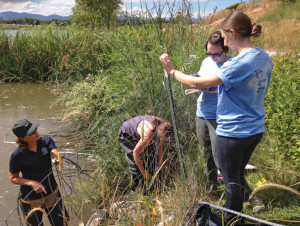
L to R: Terri Hogue, Jackie Randell, Chelsea Panos, and Lisa Cherry install a stilling well at the inlet of Berkeley Lake in Denver. Water levels are measured every five minutes and converted to flow to quantify how much stormwater runoff enters the lake over time. (Credit: Kathryn Lowe)
Saving Stormwater
Another key piece of that holistic view is something that, until recently, hadn’t been a part of the dialogue: stormwater.
“For years, stormwater was thought of as waste—something we have to deal with and get out of the city,” says Professor Terri Hogue, director of the Mines HSE Program. “Now we are totally rethinking the engineering on that and realizing it can be another source of water supply.”
Mines recently received a $2.6 million Environmental Protection Agency grant to develop a decision support tool for government agencies or housing developers interested in developing novel infrastructures to make better use of stormwater.
This year, researchers also embarked on a collaboration with the City and County of Denver to explore how proactive stormwater planning could impact the booming two-square-mile Berkeley neighborhood in Denver. With 8,000 residents, the neighborhood is expected to grow exponentially, as developers knock down single-family homes and replace them with multi-unit condos. With fewer grassy lawns to soak up water, more—and dirtier—wastewater is expected to make its way downstream. Instead, Hogue, McCray, and a group of students are crafting a plan to divert that wastewater to the Willis Case Golf Course (which is currently watered with potable water). There, green infrastructure would treat it so that it can be used for irrigation.
“We are not only taking the water and treating it; we’re also putting it to beneficial use,” says Chelsea Panos ’15, a Mines hydrology PhD student working on computer models for the project.
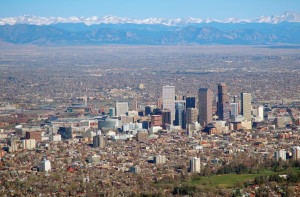
Large urban areas in the arid West, like metro Denver, have rapidly growing populations that place increasing demands on water supplies. (Credit: iStock.com/ScottBoylan)
Data-Driven Conservation
No discussion of Colorado’s water shortage solutions would be complete without talking about conservation. Statewide, according to the Colorado Water Plan, municipalities have already reduced their per-capita use by 20 percent in the past decade via voluntary and mandatory restrictions, tiered-rate structures (where customers pay more if they use more than a base amount of water), and educational initiatives.
But not all conservation initiatives work as well as others. In an effort to help municipalities understand what works best, Hogue and her students have conducted an array of usage studies in both California and Colorado.
In one recent study of Los Angeles water use patterns, she discovered several key things: Wealthier neighborhoods used three times as much water as less affluent ones; outdoor water use accounted for 54 percent of consumption; and mandatory restrictions led to a 23 percent reduction in use, while voluntary ones cut water use by only 6 percent.

This billboard from Denver Water’s 2011 “Use Only What You Need” campaign employed a strong visual to encourage Denver residents to conserve water. (Courtesy of Denver Water)
Some takeaway lessons: There’s a lot to gain by limiting outdoor water usage, and some large-volume consumers “insensitive to current pricing structures” may need to be charged even more or have their volume restricted. “There also needs to be more dual metering in urban centers—indoor and outdoor water meters—so folks are charged higher rates for excessive outdoor use,” says Hogue.
To retain additional conserved water for future use, Denver Water and other agencies are also exploring new storage options, like underground aquifers or small off-stream reservoirs. Meanwhile, the recent passage of HB 16-1005 (which allows homeowners to collect some rainwater for home use) has sparked optimism that lawmakers might be growing more amenable to tinkering with some of Colorado’s archaic water laws—in the name of conservation.
Most importantly, stakeholders from various agencies say they are, more than ever in the past, working together on solutions they might not be able to achieve alone. “I think it is a really exciting time to be in water,” says Denver Water’s Dominick. “There is a new collaborative spirit among water agencies and partners and other water users. While the challenges are very large, I think we can find the solutions.”

